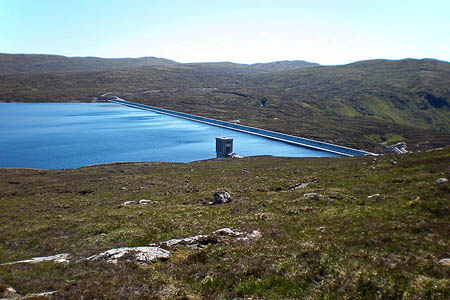
The development is planned for the hills near the Glendoe reservoir. Photo: Sarah Maguire CC-BY-SA-2.0
Scotland’s mountaineering body has joined the clamour to stop the construction of what it said would be the largest windfarm in the North of Scotland.
The Mountaineering Council of Scotland said, if the Stronelairg wind turbines were allowed to be built, no part of Scotland would be safe.
The council joined conservation charity the John Muir Trust in formally objecting to SSE Renewables Developments’ proposal to build 83 turbines in the Monadhliath Mountains, close to the Cairngorms national park.
Pressure group Save the Monadhliath Mountains has already objected to the scheme.
The MCofS said the proposed development would cover 35 sq km of uplands close to Fort Augustus and the Great Glen, and would be clearly visible from many locations in the Cairngorms national park.
It also said the windfarm construction would involve bulldozing nearly 40 miles of 5m-wide service tracks.
David Gibson, MCofS chief officer, said: “Proposals of this kind cannot pretend to be environmentally friendly. They are about big corporations making even bigger profits by industrialising the wild lands which are vital to our natural heritage.
“Approval of SSE’s Stronelairg project would prove that no part of Scotland is safe.
“We are calling on ministers to show that they really do care about the Scotland’s natural heritage by declaring an immediate moratorium on windfarms in the mountains.”
Stuart Brooks, chief executive of the John Muir Trust, said: “The rate and scale of loss of wild land in Scotland to industrialisation by windfarms is frightening, and should concern anyone who loves Scotland and its great landscapes.
“We’ve seen a huge rush of applications this year and developers are now moving into our most sensitive and precious areas.
“In the absence of a coherent energy strategy and adequate protection for Scotland’s landscapes, we are left to fight these battles on the front line at huge costs to everyone involved.
“These places are special because they are wild and beautiful. People’s jobs, the tourist industry and our wildlife depend on them. Once we industrialise wild land we change its character forever.”
The turbines are planned for an area close to the recently completed Glendoe hydroelectric scheme 11km south-east of Fort Augustus. SSE Renewables Developments said this would allow use of existing power lines for transmission, lessening the visual effects.
The MCofS has published a manifesto for the protection of mountains which calls on the Scottish Government to implement a new national spatial planning policy that harmonises the need for clean energy with the protection of Scotland’s countryside.
The North East Mountain Trust, Cairngorms Campaign and Munro Society have voiced their support for the manifesto.
George
07 September 2012More environmental devastation to line the pockets of rich landowners!